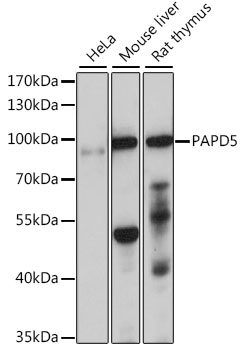-
Product Name
PAPD5 Polyclonal Antibody
- Documents
-
Description
Polyclonal antibody to PAPD5
-
Tested applications
WB
-
Species reactivity
Human, Mouse, Rat
-
Alternative names
PAPD5 antibody; TRF4-2 antibody; poly RNA polymerase D5, non-canonical antibody
-
Isotype
Rabbit IgG
-
Preparation
Antigen: Recombinant fusion protein containing a sequence corresponding to amino acids 480-590 of human PAPD5 (NP_001035374.2).
-
Clonality
Polyclonal
-
Formulation
PBS with 0.02% sodium azide, 50% glycerol, pH7.3.
-
Storage instructions
Store at -20℃. Avoid freeze / thaw cycles.
-
Applications
WB 1:500 - 1:2000
-
Validations

Western blot - PAPD5 Polyclonal Antibody
Western blot analysis of extracts of various cell lines, using PAPD5 antibody at 1:1000 dilution.Secondary antibody: HRP Goat Anti-Rabbit IgG (H+L) at 1:10000 dilution.Lysates/proteins: 25ug per lane.Blocking buffer: 3% nonfat dry milk in TBST.Detection: ECL Basic Kit .Exposure time: 90s.
-
Background
Terminal nucleotidyltransferase that catalyzes preferentially the transfert of ATP and GTP on RNA 3' poly(A) tail creating a heterogeneous 3' poly(A) tail leading to mRNAs stabilization by protecting mRNAs from active deadenylation. Also functions as a catalytic subunit of a TRAMP-like complex which has a poly(A) RNA polymerase activity and is involved in a post-transcriptional quality control mechanism. Polyadenylation with short oligo(A) tails is required for the degradative activity of the exosome on several of its nuclear RNA substrates. Doesn't need a cofactor for polyadenylation activity (in vitro). Required for cytoplasmic polyadenylation of mRNAs involved in carbohydrate metabolism, including the glucose transporter SLC2A1/GLUT1. Plays a role in replication-dependent histone mRNA degradation, probably through terminal uridylation of mature histone mRNAs. May play a role in sister chromatid cohesion. Mediates 3' adenylation of the microRNA MIR21 followed by its 3'-to-5' trimming by the exoribonuclease PARN leading to degradation. Mediates 3' adenylation of H/ACA box snoRNAs (small nucleolar RNAs) followed by its 3'-to-5' trimming by the exoribonuclease PARN which enhances snoRNA stability and maturation.
Related Products / Services
Please note: All products are "FOR RESEARCH USE ONLY AND ARE NOT INTENDED FOR DIAGNOSTIC OR THERAPEUTIC USE"
